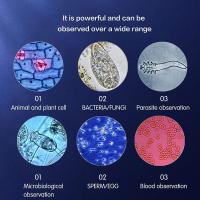900x Microscope What Can You See ?
With a 900x microscope, you can see very small objects and details that are not visible to the naked eye. You can observe the structure of cells, bacteria, and other microorganisms. You can also see the fine details of plant and animal tissues, such as the arrangement of cells and the shape of organelles. Additionally, you can examine the surface of materials, such as metals, plastics, and fabrics, to observe their texture and composition. With a 900x microscope, you can explore the microscopic world and gain a deeper understanding of the complex structures and processes that make up our world.
1、 Cellular Structures

With a 900x microscope, you can see cellular structures that are not visible to the naked eye. These structures include the cell membrane, cytoplasm, nucleus, mitochondria, ribosomes, and other organelles. The cell membrane is a thin layer that surrounds the cell and controls the movement of substances in and out of the cell. The cytoplasm is a gel-like substance that fills the cell and contains various organelles. The nucleus is the control center of the cell and contains the genetic material, DNA.
Mitochondria are the powerhouses of the cell and produce energy in the form of ATP. Ribosomes are responsible for protein synthesis, and other organelles such as the endoplasmic reticulum and Golgi apparatus are involved in the processing and transport of proteins.
Recent advances in microscopy techniques have allowed scientists to study cellular structures in greater detail. For example, super-resolution microscopy techniques such as STED and PALM have enabled researchers to visualize structures at the nanoscale level. This has led to new insights into the organization and function of cellular structures, such as the discovery of nanoscale protein clusters in the cell membrane.
In conclusion, a 900x microscope allows us to see cellular structures that are essential for the functioning of living organisms. With the latest microscopy techniques, we can study these structures in greater detail and gain a deeper understanding of how they work.
2、 Microorganisms

With a 900x microscope, you can see a wide range of microorganisms that are not visible to the naked eye. These include bacteria, viruses, fungi, and protozoa. These microorganisms are found in various environments, including soil, water, and air. They play a crucial role in the ecosystem, as they are involved in nutrient cycling, decomposition, and other important processes.
Bacteria are the most common microorganisms that can be seen with a 900x microscope. They are single-celled organisms that come in various shapes and sizes. Some bacteria are beneficial, while others can cause diseases. Viruses are much smaller than bacteria and can only be seen with an electron microscope. They are not considered living organisms as they cannot reproduce on their own and require a host cell to do so.
Fungi are another type of microorganism that can be seen with a 900x microscope. They are multicellular organisms that play an important role in decomposition and nutrient cycling. Some fungi are also used in the production of food and medicine. Protozoa are single-celled organisms that are found in water and soil. They are important in the food chain as they are a source of food for other organisms.
Recent studies have shown that microorganisms play a crucial role in human health. The human microbiome, which is the collection of microorganisms that live in and on the human body, has been linked to various health conditions, including obesity, diabetes, and autoimmune diseases. Understanding the role of microorganisms in human health is an area of active research, and the use of advanced microscopy techniques, such as the 900x microscope, is helping to advance our understanding of these tiny organisms.
3、 Blood Cells

With a 900x microscope, you can see blood cells in great detail. Blood cells are the components of blood that carry oxygen, nutrients, and waste products throughout the body. There are three types of blood cells: red blood cells, white blood cells, and platelets.
Red blood cells, also known as erythrocytes, are the most abundant type of blood cell. They are responsible for carrying oxygen from the lungs to the rest of the body. Under a 900x microscope, you can see that red blood cells are small, biconcave discs that are about 7 micrometers in diameter. They appear red due to the presence of hemoglobin, a protein that binds to oxygen.
White blood cells, also known as leukocytes, are the cells of the immune system that protect the body against infection and disease. Under a 900x microscope, you can see that white blood cells are larger than red blood cells and have a more irregular shape. There are several types of white blood cells, each with a specific function.
Platelets, also known as thrombocytes, are small, irregularly shaped cells that are involved in blood clotting. Under a 900x microscope, you can see that platelets are much smaller than red or white blood cells and have a spiky appearance.
Recent studies have shown that blood cells can provide valuable information about a person's health. For example, changes in the size, shape, and number of blood cells can indicate the presence of certain diseases or conditions. By examining blood cells under a 900x microscope, doctors and researchers can gain insights into the health of an individual and develop new treatments for a variety of illnesses.
4、 Plant Cells

With a 900x microscope, you can see the intricate details of plant cells. Plant cells are unique in that they have a rigid cell wall made of cellulose, which provides structural support and protection. The cell wall is visible under a microscope and appears as a thin, dark line surrounding the cell.
Inside the cell, you can see the nucleus, which contains the plant's genetic material. The nucleus appears as a dark, spherical structure within the cell. You can also see the cytoplasm, which is the gel-like substance that fills the cell and contains various organelles.
One of the most prominent organelles visible under a microscope is the chloroplast. Chloroplasts are responsible for photosynthesis, the process by which plants convert sunlight into energy. They appear as small, green structures within the cell.
Other organelles that can be seen include the mitochondria, which are responsible for cellular respiration, and the endoplasmic reticulum, which is involved in protein synthesis and lipid metabolism.
Recent advances in microscopy technology have allowed scientists to study plant cells in even greater detail. For example, super-resolution microscopy techniques can reveal the precise location of individual molecules within the cell, providing new insights into cellular processes.





























There are no comments for this blog.